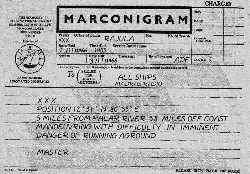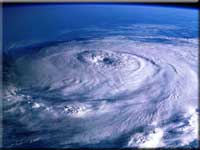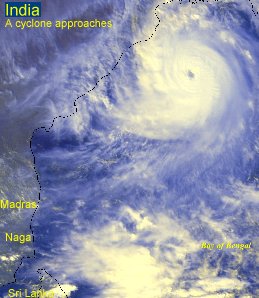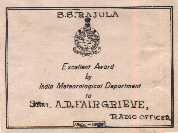
by Martin D. Cotsford -
Third Officer 'Rajula'- British India Steam Navigation Company applepie@bigpond.net.au
Through Andrew "Scruggs" Fairgrieve - ex sparks - BI
Quo Vadis ... where do you want to go??!!
Astern.....Previous sea story
THE MADRAS CYCLONE 1966
THIS IS A FACTUAL ACCOUNT of the weather conditions and subsequent difficulty which was experienced to keep the Rajula off a lee shore during the cyclone which hit the Madras Coast on 3rd November 1966.
We have endeavoured to describe the events as they happened, without exaggeration and trying to over-dramatise.
The story has its beginning when a weather report received by the ship on 1st November stated that a low cyclonic depression had formed over the South Andaman Sea and was moving slowly westwards.
Later reports stated that it had strengthened and increased its speed to 25 knots.
We arrived at Nagapattinam anchorage on the morning of the 2nd but conditions were such that the port authorities refused to disembark our passengers or discharge our cargo.
However a group of about 22 Customs and Immigration officials boarded hoping to spend an enjoyable evening aboard after they had discharged their duties.
 After we had sailed from Nagapattinam we received two more T.T.T.s (Storm Warnings), informing us that the cyclone was much closer and should cross the Indian coast close to Nagapatinam. We were heading North towards Madras, and at midnight on the 2nd we were off Pondicherry. It was then that the first rain squalls hit us. The weather previous to this had been deteriorating but was nothing abnormal.
After we had sailed from Nagapattinam we received two more T.T.T.s (Storm Warnings), informing us that the cyclone was much closer and should cross the Indian coast close to Nagapatinam. We were heading North towards Madras, and at midnight on the 2nd we were off Pondicherry. It was then that the first rain squalls hit us. The weather previous to this had been deteriorating but was nothing abnormal.
The sea was moderate to rough, wind N.W. force 5/6, barometer 1008 mbs and still following its normal diurnal curve. From midnight to 0300 hours on the 3rd the barometer dropped sharply to 1002.6 mbs then steadied up. This gave those concerned a false sense of security, that the cyclone was indeed passing well to the South of us, and that we were just feeling the outer fringe weather.
The engines were placed on standby from 0351 hours due to reduced visibility in rain squalls. From 0300 to 0900 hours the barometer fell very gradually from 1002.6 to 1000.2 mbs. but the wind was veering from NW to North and had strengthened from force 8 to 10.
During this period the ship was still proceeding North, being off Covelong Point at 0600 hours (see diagram of ship's progress). At 0715 difficulty was experienced in maintaining the steered course of 013(True) and 5 deg. of starboard leeway was allowed which held her on course until 0815, when with 11 deg. leeway was allowed. The ship was making about 3 knots forward progress at this stage, the wind and sea being right ahead, and she was pitching heavily at times.
 By 0900 hours we were eight miles off the Madras Breakwater and on the radar we could see approximately 20 ships anchored off, the visibility at this point being one mile. Several of the ships were seen to move seawards so we altered course to 060(T) so as to be well clear of them and also to give ourselves more sea room. We actually saw visually one of these ships pass about one mile from us . . . we believe it was the State of Rajasthan, because we kept track of her on the P.P.I. and saw her go aground just south of Covelong Point.
By 0900 hours we were eight miles off the Madras Breakwater and on the radar we could see approximately 20 ships anchored off, the visibility at this point being one mile. Several of the ships were seen to move seawards so we altered course to 060(T) so as to be well clear of them and also to give ourselves more sea room. We actually saw visually one of these ships pass about one mile from us . . . we believe it was the State of Rajasthan, because we kept track of her on the P.P.I. and saw her go aground just south of Covelong Point.
Shortly after 0900 hours the barometer commenced to plunge, and the wind was still increasing in force and veering.
We managed to maintain steerage way until 1030 hours; then after that she would not answer the helm, and she lay in the trough of the waves with the wind about three points on the port bow and rose and fell with mountainous waves. We had managed to clear the coast by 11 miles.
From 0900 to 1440 hours the barometer dropped vertically from 1000.2 to 961 mbs. and it was during this time the ship came within imminent danger of being swept aground on to the lee shore. After we had lost all steerage way we were swept bodily southwards by the inblowing winds towards the cyclone's centre. We were caught in the dangerous quadrant, as were about 20 other ships in vicinity.
By midday our position was 10 miles to seaward of Covelong Point, but then the wind veered still further and we were set down rapidly towards the coast. The Captain (Toby Blackett) tried various manoeuvres to get the ship's head up to the wind and steam away from the coast. We tried going ahead on one engine and astern on the other, both ways, but she refused to budge an inch.
At 1400 hours the wind was still increasing and had veered further and was now blowing from the south-east. We estimated that the wind force was anything from force 15 to 17 i.e. over 100 m.p.h. Seas were mountainous being well over 50 feet high and towering above the top of the samson posts. It was a miracle how they didn't just collapse on the foredeck, but somehow the Raj came up to meet them.
One must pay tribute to the excellent seaworthiness of the Rajula, there are few ships that could have come through an ordeal like this as unscathed as she did. The rev. counters for both propellers were fluctuating from nil to off the scale as the props came out of the water, especially the port propeller because the ship had a permanent list to starboard due to the force of the wind on the port side, and the engineers had their work cut out in controlling the engines by hand. The air was full of spray and driving torrential rain. Visibility was absolutely nil.
We had a very close shave on the bridge when the glass from one of the outer port windows disintegrated and whipped across in front of us as though it was a piece of paper. The wind pressure was so great that the port side wheel-house doors had to be braced by nailing timbers across.
It was at the height of the storm that one of the older members of the crew struggled up to the bridge in his longee, minus his glasses which he had lost on the way, and begged the captain to be allowed to go up to the monkey island to pray. He assured us that he would pray to all the gods. Needless to say his wish was not granted, as he would have most certainly been swept over the side.
We lost seven life rafts which were blown bodily off various upper decks by the force of the gale.
Meanwhile we were being rapidly set down on to the coast and, at 1409 hours, the port anchor was let go in the hope that even if it didn't hold us, it would bring our head to the wind, and we could hold our own with the engines until such time as the storm eased. Those who went up on to the foc'sle head hung on for grim death. (Does anyone know who were those heroes?) The anchor was walked back for one shackle, then let run to six, but it snapped like a piece of cotton as soon as the first weight came on it.
Things were now becoming very serious, and at 1420 we sent out an X.X.X. (Urgency Signal) stating that our position was five miles from the Palar River entrance and 3.8 miles off the coast, and that we were manoeuvring with difficulty, and in imminent danger of grounding.
By 1425 hours we were 3 1/2 miles off the coast and perhaps a matter of minutes away from going aground.
 It was then that the last possible manoeuvre left open to us was tried. Both engines were placed on full astern. For those readers who are not conversant with what this manoeuvre does in these circumstances, the following is a brief outline. If a vessel is being blown on to a lee shore (i.e. the wind is blowing from the sea towards the shore), when the engines are put on full astern, because the turning point of the ship comes then right over the rudder post, the ship's stern will come up into the wind. This is what happened in the Rajula's case, but the manoeuvre is considered dangerous because it then exposes the stern, rudder and propellers to the full force of the seas.
It was then that the last possible manoeuvre left open to us was tried. Both engines were placed on full astern. For those readers who are not conversant with what this manoeuvre does in these circumstances, the following is a brief outline. If a vessel is being blown on to a lee shore (i.e. the wind is blowing from the sea towards the shore), when the engines are put on full astern, because the turning point of the ship comes then right over the rudder post, the ship's stern will come up into the wind. This is what happened in the Rajula's case, but the manoeuvre is considered dangerous because it then exposes the stern, rudder and propellers to the full force of the seas.
As full astern was rung the sea was muddy brown, giving us yet another indication of our proximity to the shore. This was our last chance to clear the coast . . . would it come off? While one of us stood braced at the radar (Ted Treacher?) the rest of us on the bridge held our breath. After several minutes had elapsed came the terse comment 'I think we are holding our own.' Then after another four or five minutes had passed came the excited yell 'Yes, I think we are gaining' . . . and sure enough we were very slowly making ground away from the coast.
The Rajula's stern took a terrific battering but luckily it is such a high stern that we were not pooped or received any damage to the rudder. This was the turning point for the best because shortly after 1440 hours the barometer stopped dropping at a phenominal low of 961 mbs and commenced to rise just as rapidly as it had dropped.
As a matter of interest we actually saw on the P.P.I. (Radar Screen) the centre of the cyclone cross the Indian coast close to the Palar River. We estimated we were no more than 10 miles from the eye or vortex. Sternway was made off the coast for two hours 22 minutes from 1425 to 1647, when the wind dropped sufficiently to force 10, we were able to turn around and steam forwards seaward.
During the course of the storm much was going on which hasn't been recorded so far. Here are a few things of interest.
The passengers (There were 1,323 of them aboard) behaved very well. The majority of the saloon passengers kept to their cabins except a few who sat up in a corner of the dining saloon, which was a shambles, and laughed and joked to keep their spirits up. (Marin told me "spirits" actually meant much whisky!) One of them was an American lady who prior to this had stated that she wished to experience a really bad storm at sea. Her wish was granted.
The 'tween deck passengers were having a rough time of it down in the bowels of the ship as 'B' deck was running with water at places. One ingenious man had lashed his trunk to a ventilator post and had placed his bedding on top of it so as to be clear of the water, and had also lashed himself to the post and slept blissfully through most of it.
As a result of the cyclone which caused havoc along the Madras coastal belt many were homeless and five deaths were recorded in Madras city.
Four ships were blown aground, the worst hit being the S.S. Progress, an all Chinese crew ship of which 26 perished when she was swept up onto Madras breakwater. Another of the ships aground, the Mari Hora, has also broken up.
We on board the Rajula consider we have had a miraculous escape, from what could have been a disastrous grounding, and are now fully aware that Tropical Revolving Storms are one of the most violent forces that nature can evolve.
 BINNY & CO. MADRAS, have sent us the following report:
On 3RD NOVEMBER Madras was struck by one of the worst cyclones ever experienced. A deluge of rain and gales up to 90 knots lashed the city from early morning up to late afternoon with unabated fury. Of the ships anchored at roads, four vessels were driven ashore. Progress in fact smashed against the breakwater arm and sank up to its rail. The others, Stematis, Mari Hora, and State of Rajasthan beached further south, the Mari Hora splitting herself amidships. 18 lives were lost among the Chinese crew of Progress, although immediate rescue measures were attempted. State of Rajasthan has since been successfully refloated.
BINNY & CO. MADRAS, have sent us the following report:
On 3RD NOVEMBER Madras was struck by one of the worst cyclones ever experienced. A deluge of rain and gales up to 90 knots lashed the city from early morning up to late afternoon with unabated fury. Of the ships anchored at roads, four vessels were driven ashore. Progress in fact smashed against the breakwater arm and sank up to its rail. The others, Stematis, Mari Hora, and State of Rajasthan beached further south, the Mari Hora splitting herself amidships. 18 lives were lost among the Chinese crew of Progress, although immediate rescue measures were attempted. State of Rajasthan has since been successfully refloated.
Rajula with 1400 passengers was caught in the cyclone soon after she reached within 10 miles of the Madras Coast on the 3rd morning. The local Agents' representative, who was making a round trip, was on board the vessel during the cyclone and we have his account of the experience:
'From 3 a.m. on the 3rd, sheets of rain descended accompanied by howling gales . . . By 7 a.m. the wind had intensified to 120 knots causing heavy rolling . . . all movable furniture and crockery had piled up on the Starboard side of the dining saloon. At 2 o'clock in the afternoon the cyclone was at its worst, with waves pouring over Rajula's side reaching up as far up as the bridge.
'It was at this time that the Chief Officer and Extra Chief Officer (Ray Windle and whom?) were found securing, at much risk to themselves, the after starboard lifeboat which had worked loose and would have smashed itself against the steel supports . . awnings were blown away, glassware smashed, television sets fallen. deck accommodation flooded . . . while Rajula fought the giant waves and wind.
'She was however blown 30 miles south to within 3 1/2 miles off the rocky Mahabalipuram Coast. One anchor with six lengths of cable was lost, when Rajula attempted to anchor.
'Rajula finally returned to Madras on the 4th morning and berthed at about 1 p.m. amidst cheers from grateful passengers.'
(Note: First published in the BI news magazine)

View My Guestbook
Sign My Guestbook
 Back Home
Back Home
Ahead....Next sea story
Home
Source - Andrew Fairgrieve's webpage